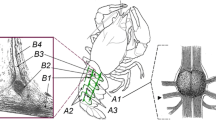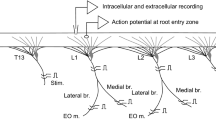Abstract
-
1.
Nerve cord transection abolishes the ability of crayfish (Procambarus clarkii) to produce tailflips in response to gradually applied tactile or proprioceptive stimulation of the abdomen, but this ability eventually returns. To determine the time-course of this return and to analyze its underlying neural pathways, we made behavioral observations, electromyographic recordings from abdominal phasic flexor muscles, and intracellular recordings from motoneurons in crayfish with cord lesions between the thorax and the abdomen.
-
2.
Abdominal stimulation activated the phasic flexor muscles in the rostral 5 abdominal segments and their homologs in the 6th segment, the posterior telson flexor muscles. Nearly one-quarter of cord-transected animals responded to the stimuli with phasic flexor muscle activity by one week after the lesion, and almost 90% were responsive by 3 weeks.
-
3.
Regeneration of axons across the lesion played little or no role in the recovery of phasic flexor muscle responsiveness. In addition, the lateral giant axons were not activated by the gradually applied stimuli that triggered phasic flexor muscle contractions. These results suggest that non-giant pathways confined to the abdominal nervous system become functional following chronic cord transection.
-
4.
Retransection of the nerve cord below the original lesion showed that smaller subsets of the abdominal cord, including a single ganglion, could develop the ability to generate phasic flexor muscle contractions in response to gradually applied stimuli.
-
5.
Phasic flexor motoneurons in cord-transected animals could be excited by stimulation of afferents throughout the abdomen. The sensory pathways producing this activation appear to project through the nerve cord without much cross-over between left and right sides.
Similar content being viewed by others
Abbreviations
- EMG :
-
electromyographic
- FF :
-
fast flexor
- LG :
-
lateral giant
- MG :
-
medial giant
- PTF :
-
posterior telson flexor
- SEG :
-
subesophageal ganglion
- T-A :
-
thoracoabdominal
References
Brenowitz GL, Pubols LM (1981a) Increased response to sural nerve input in the dorsal horn following chronic spinal cord hemisection. Brain Res 208:421–425
Brenowitz GL, Pubols LM (1981b) Increased receptive field size of dorsal horn neurons following chronic spinal cord hemisection in cats. Brain Res 216:45–59
Darian-Smith C, Gilbert CD (1994) Axonal sprouting accompanies functional reorganization in adult cat striate cortex. Nature 368:737–740
de Groat WC, Nadelhaft I, Milne RJ, Booth AM, Morgan C, Thor K (1981) Organization of the sacral parasympathetic reflex pathways to the urinary bladder and large intestine. J Auton Nerv Syst 3:135–160
Dumont JPC, Wine JJ (1987) The telson flexor neuromuscular system of the crayfish. I. Homology with the fast flexor system. J Exp Biol 127:249–277
Eidelberg E (1981) Consequences of spinal cord lesions upon motor function, with special reference to locomotor activity. Prog Neurobiol 17:185–202
Gilbert CD, Wiesel TN (1992) Receptive field dynamics in adult primary visual cortex. Nature 356:150–152
Glidden R, Kirk MD (1991) Neural pathways underlying behavioral plasticity in response to nerve cord transection in the crayfish. Soc Neurosci Abstr 17:1389
Gustafsson B, Katz R, Malmsten J (1982) Effects of chronic partial deafferentation on the electrical properties of lumbar α-motoneurones in the cat. Brain Res 246:23–33
Guttmann L (1976) Spinal cord injuries: comprehensive management and research. Blackwell Scientific Publications, Oxford London Edinburgh Melbourne
Hall PV, Smith JE, Lane J, Mote T, Campbell R (1979) Glycine and experimental spinal spasticity. Neurology 29:262–267
Kao CY (1960) Postsynaptic electrogenesis in septate giant axons. II. Comparison of medial and lateral giant axons of crayfish. J Neurophysiol 23:618–635.
Kenne JH, Ketteler HJ, Kane JM, McCloskey TC, Senyah Y, Palfreyman MG (1992) MDL 27,531 reduces spontaneous hindlimb contractions in rats with chronic transections of the spinal cord. Neurosci Lett 147:101–105
Keller A, Arissian K, Asanuma H (1990) Formation of new synapses in the cat motor cortex following lesions of the deep cerebellar nuclei. Exp Brain Res 80:23–33
Kirkwood PA, Sears TA, Westgaard RH (1984) Restoration of function in external intercostal motoneurones of the cat following partial central deafferentation. J Physiol (Lond) 350:225–251
Kramer AP, Krasne FB (1984) Crayfish escape behavior: production of tailflips without giant fiber activity. J Neurophysiol 52:189–211
Kramer AP, Krasne FB, Wine JJ (1981) Interneurons between giant axons and motoneurons in crayfish escape circuitry. J Neurophysiol 45:550–573
Krasne FB, Glanzman DL (1986) Sensitization of the crayfish lateral giant escape reaction. J Neurosci 6:1013–1020
Krasne FB, Wine JJ (1975) Extrinsic modulation of crayfish escape behaviour. J Exp Biol 63:433–450
Kristan WB Jr (1979) Neuronal changes related to behavioral changes in chronically isolated segments of the medicinal leech. Brain Res 167:215–220
Kristan WB Jr, Guthrie PB (1977) Acquisition of swimming behavior in chronically isolated single segments of the leech. Brain Res 131:191–195
Larimer JL, Kennedy D (1969) Innervation patterns of fast and slow muscle in the uropods of crayfish. J Exp Biol 51:119–133
Lee MT, Wine JJ (1984) Plasticity of non-giant flexion circuitry in chronically cut abdominal nerve cords of the crayfish, Procambarus clarkii. J Physiol (Lond) 355:661–675
Mendell LM (1984) Modifiability of spinal synapses. Physiol Rev 64:260–324
Mittenthal JE, Wine JJ (1973) Connectivity patterns of crayfish giant interneurons: visualization of synaptic regions with cobalt dye. Science 179:182–184
Nelson SG, Mendell LM (1979) Enhancement in Ia-motoneuron synaptic transmission caudal to chronic spinal cord transection. J Neurophysiol 42:642–654
Pettit MJ, Schwark HD (1993) Receptive field reorganization in dorsal column nuclei during temporary denervation. Science 262:2054–2056
Reichert H, Wine JJ (1983) Coordination of lateral giant and non-giant systems in crayfish escape behavior. J Comp Physiol 153:3–15
Reichert H, Wine JJ, Hagiwara G (1981) Crayfish escape behavior: neurobehavioral analysis of phasic extension reveals dual systems for motor control. J Comp Physiol 142:281–294
Schrameck JE (1970) Crayfish swimming: alternating motor output and giant fiber activity. Science 169:698–700
Sigvardt KA, Hagiwara G, Wine JJ (1982) Mechanosensory integration in the crayfish abdominal nervous system: structural and physiological differences between interneurons with single and multiple spike initiating sites. J Comp Physiol 148:143–157
Turrigiano G, Abbott LF, Marder E (1994) Activity-dependent changes in the intrinsic properties of cultured neurons. Science 264:974–977
Van Harreveld A (1936) A physiological solution for fresh water crustaceans. Proc Soc Exp Biol Med 34:428–432
Wine JJ (1975) Crayfish neurons with electrogenic cell bodies: correlations with function and dendritic properties. Brain Res 85:92–98
Wine JJ (1984) The structural basis of an innate behavioral pattern. J Exp Biol 112:283–319
Wine JJ, Krasne FB (1972) The organization of escape behaviour in the crayfish. J Exp Biol 56:1–18
Wine JJ, Krasne FB (1982) The cellular organization of crayfish escape behavior. In: Sandeman DC Atwood HL (ed) The biology of Crustacea. Vol. IV. Academic Press, New York, pp 241–292
Author information
Authors and Affiliations
Rights and permissions
About this article
Cite this article
Lee, M.T., Young, S.M., Jackson, D.A. et al. Pathways mediating abdominal phasic flexor muscle activity in crayfish with chronically cut nerve cords. J Comp Physiol A 176, 91–102 (1995). https://doi.org/10.1007/BF00197755
Accepted:
Issue Date:
DOI: https://doi.org/10.1007/BF00197755




